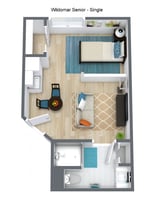If you’re looking for a comfortable and convenient living option for yourself or a loved one,...
Helping A Loved One Transition into Assisted Living
“How will my loved one adjust to moving into an Assisted Living?” Anyone who works with families considering moving their loved one into a community hears this question. We always want to reassure the family that they will of course adjust and most of the time they do. However, finding ways to help this adjustment can help everyone during this process. I have not only had the experience of helping other families in this situation but also as the adult daughter of a parent who lived in an assisted living well, I want to share some ideas on how to assist new residents to adjust, make new friends and adapt to their new life in a community.
In our experience, adding a personal touch can truly make a difference. By taking the time to understand a resident's likes, dislikes, and care needs, you can better provide them with joy and contentment. Engage in meaningful conversations with the resident and their family, delving into their career history, hobbies, and interests. Family members are an invaluable resource, as they can offer insights and help create a sense of connection. Practicing active listening, where you give your undivided attention without interruption or personal input, can be incredibly therapeutic and effective in building connections. Ultimately, when individuals move into assisted living, they desire to feel cared for and valued. These two factors, above all else, have the greatest impact on their adjustment and overall well-being.
Here are a few ways Wildomar Senior Assisted Living helps new residents make friends and fit in:
- Using a team approach:
-Sharing information with the whole team, not just the activity staff but the front desk, the chef, and of course the caregiving team.
-Putting new residents as “priority” just as if they have a high care need. Giving them TLC and helping them feel valued.
-Share updates on the resident's progress in daily team meetings.
- Making a plan:
-A care plan meeting is scheduled with the resident and family within 2 weeks of moving in. We come up with a team approach to involve the resident in activities and make sure their needs are identified and addressed.
- Connecting those with similar backgrounds:
-Bring residents with similar backgrounds together for coffee, or in the dining room. Help them get the conversation started.
-Some types of commonalities are veterans, residents who grew up on the East Coast, animal lovers, and people who enjoy similar activities, etc.
- Involve Family:
-Encouraging family to talk with their loved one about how they are doing and share the feedback with us.
-Ask the family to bring in photos of the residents from their younger days. It’s fun to look at their old photos and a great way to start a conversation.
- Maintaining social connection:
-We welcome groups from the outside with whom a new resident has a connection such as the “Red Hat Society”, and “Garden Clubs”. Many outside clubs are happy to have an opportunity to make sure they stay in touch with their members. When residents are connected and engaged in our community, it makes life more enjoyable for them and adds value to their lives.

